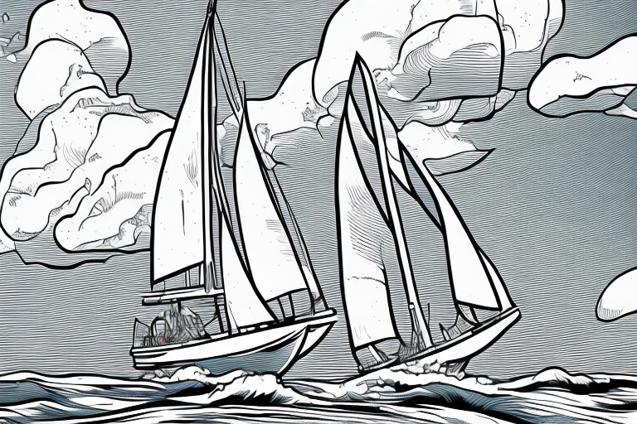
Understanding sailboat anatomy and terminology is crucial for safe and efficient sailing, whether you're a beginner or a seasoned sailor.
The Basics of Sailboat Anatomy and Terminology
Welcome to the first installment of our Sailing Basics series! In this article, we’ll be diving into the world of sailboat anatomy and terminology. Whether you’re a complete beginner or a seasoned sailor looking for a refresher, this comprehensive guide will help you navigate the ins and outs of sailboats and their various components.
As you embark on your sailing journey, it’s essential to familiarize yourself with the different parts of a sailboat and the terms used to describe them. This knowledge will not only help you communicate effectively with fellow sailors but also ensure that you can safely and efficiently operate your vessel.
So, without further ado, let’s set sail and explore the basics of sailboat anatomy and terminology!
Hull
The hull is the main body of the sailboat, providing buoyancy and stability in the water. It’s typically made of fiberglass, wood, or metal, and its shape and design can vary depending on the type of sailboat. The hull is divided into several sections, including the bow (front), stern (rear), port (left side), and starboard (right side).
Keel
The keel is a long, flat structure that extends from the bottom of the hull and runs along its centerline. It serves several purposes, including providing stability, preventing the boat from being blown sideways by the wind, and acting as a counterbalance to the force of the sails. There are different types of keels, such as fin keels, full keels, and wing keels, each with its own advantages and disadvantages.
Rudder
Located at the stern of the boat, the rudder is a flat, vertical blade that helps steer the sailboat by controlling its direction in the water. It’s connected to the tiller or wheel, which the helmsman (person steering the boat) uses to turn the rudder and change the boat’s course.
Deck
The deck is the horizontal surface that covers the hull and provides a platform for crew members to stand on and operate the sailboat. It’s usually made of the same material as the hull and can be divided into several areas, such as the foredeck (front), cockpit (middle), and aft deck (rear).
Cockpit
The cockpit is the central area of the deck where the crew operates the sailboat. It typically contains the helm (tiller or wheel), engine controls, and various instruments, such as a compass, GPS, and wind indicators. The cockpit is also where the crew can access the cabin below deck.
Lifelines
Lifelines are a series of cables or ropes that run along the perimeter of the deck, providing a safety barrier to prevent crew members from falling overboard. They’re usually attached to stanchions (vertical posts) and may also include gates for boarding the boat from a dock or dinghy.
Mast and Rigging
The mast is a tall, vertical pole that supports the sails and rigging. It’s usually made of aluminum or carbon fiber and can be stepped (attached) to the keel or deck, depending on the sailboat’s design. The rigging consists of various lines, cables, and hardware that connect the mast, sails, and hull, allowing the crew to control the sails and maneuver the boat.
Standing Rigging
Standing rigging refers to the fixed lines and cables that support the mast and maintain its position. The main components of standing rigging include:
- Shrouds: Cables that run from the top of the mast to the sides of the hull, providing lateral support.
- Stays: Cables that run from the top of the mast to the bow (forestay) and stern (backstay), providing fore-and-aft support.
Running Rigging
Running rigging consists of the lines and hardware used to control the sails, allowing the crew to raise, lower, and adjust them as needed. Some key components of running rigging include:
- Halyards: Lines used to hoist (raise) the sails up the mast.
- Sheets: Lines used to control the angle of the sails relative to the wind.
- Outhaul: A line used to adjust the tension of the mainsail along the boom.
- Cunningham: A line used to adjust the tension of the mainsail along the luff (front edge).
Sails
Sails are the primary means of propulsion for a sailboat, harnessing the power of the wind to move the boat through the water. There are two main types of sails: mainsails and headsails.
Mainsail
The mainsail is the largest sail on the boat and is attached to the mast and boom. It’s typically triangular in shape, with its leading edge (luff) connected to the mast, its bottom edge (foot) connected to the boom, and its trailing edge (leech) left free. The mainsail is controlled using the mainsheet, outhaul, and cunningham.
Headsail
Headsails, also known as jibs or genoas, are smaller sails located in front of the mast. They’re attached to the forestay and are used to improve the boat’s performance, especially when sailing upwind. Headsails can be controlled using sheets and may be furled (rolled up) when not in use.
Conclusion
Now that you have a basic understanding of sailboat anatomy and terminology, you’re well on your way to becoming a confident and knowledgeable sailor. As you continue to explore the world of sailing, you’ll undoubtedly encounter more specialized terms and components, but this guide should serve as a solid foundation for your ongoing education.
In the next installment of our Sailing Basics series, we’ll be covering essential sailing skills, such as tacking, jibing, and docking. Until then, fair winds and smooth seas!